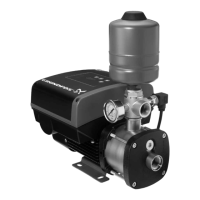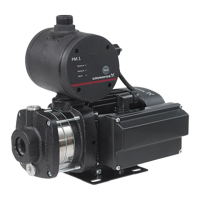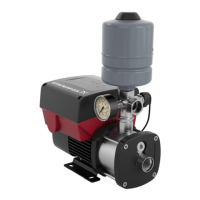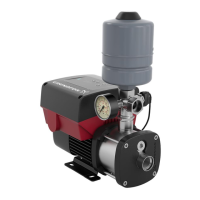English (GB)
30
13.5.3 "Constant differential pressure"
The pump maintains a constant differential pressure,
independently of the flow in the system. See fig. 30.
Fig. 30 "Constant differential pressure"
This control mode requires either a
differential-pressure sensor or two external pressure
sensors. See the examples below:
Fig. 31 "Constant differential pressure"
Controller settings
For recommended controller settings, see section
13.12 "Controller" (Controller settings).
Factory setting
See section 24. Factory settings.
13.5.4 "Constant differential temperature"
The pump maintains a constant differential
temperature in the system and the pump
performance is controlled according to this. See fig.
32.
Fig. 32 "Constant differential temperature"
This control mode requires either two temperature
sensors or one differential-temperature sensor. See
the examples below. The temperature sensors can
either be analog sensors connected to two of the
analog inputs or two Pt100/Pt1000 sensors
connected to the Pt100/1000 inputs, if these are
available on the specific pump.
Set the sensor in the Assist menu under Assisted
pump setup. See section 13.42 Assisted pump
setup.
Pump variant
"Constant differential
pressure"
CME ●
CRE, CRIE, CRNE,
SPKE, MTRE
●
TM05 7901 1613
Examples
• One differential-pressure sensor.
The pump uses the input from the sensor to
control the differential pressure.
You can set the sensor manually or by using the
Assist menu. See section 13.42 Assisted pump
setup.
• Two pressure sensors.
Constant differential-pressure control is
achievable with two pressure sensors. The
pump uses the inputs from the two sensors and
calculates the differential pressure.
Both sensors must have the same unit and must
be set as feedback sensors. You can set the
sensors manually, sensor by sensor, or by using
the Assist menu. See section 13.42 Assisted
pump setup.
Pump variant
"Constant differential
temperature"
CME ●
CRE, CRIE, CRNE,
SPKE, MTRE
●
TM05 7954 1713

